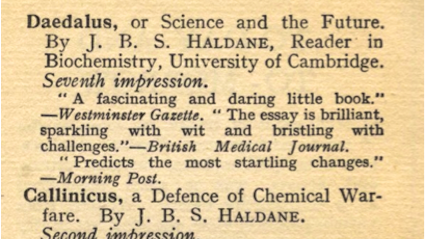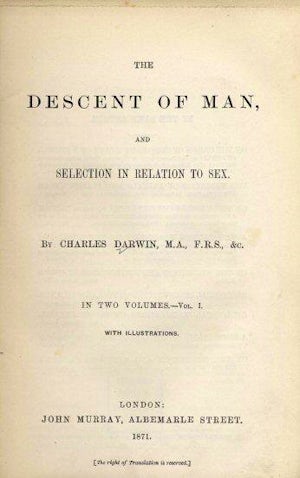
J. B. S. Haldane’s Daedalus, or Science and the Future is published in the To-day and To-morrow Series
1923. With the initial contribution by the great British biologist and science popularizer J.B.S. Haldane (1892-1964), Daedalus, or Science and the Future (1923), the To-day and To-morrow series of popular books began a decade-long tradition of describing the current status of science, technology and/or society, and forecasting a mostly progressive future. But as the ‘progressive-era’ of the pre-World War I period collided with the post-war ‘age of anxiety’, that future was now clouded with biological, technological, and sociological anxiety and controversy. This series of pocketbooks, described as ‘pamphlets’ by London publisher Kegan Paul, Trench & Trubner (simultaneously published in New York by E.P. Dutton) explored these controversies, including eugenics. See the series advertising copy of selected ‘critical’ reviews in the accompanying picture. Haldane’s greatest scientific prestige arose from being one of the scientists that developed the Modern Evolutionary Synthesis, unifying Mendelian genetics, biometrics and Darwinian evolution, but it was his talent as a prolific popularizer of science (and his later overt support for Stalin’s USSR) that made him famous among the general public.
Most of the titles for the individual volumes evoked apropos classical Greek or Roman heroes and other mythological figures, like Daedalus or Icarus. They also shared a common formula of describing the present situation (and sometimes the past that led to it), then forecasting the future for the next century or so. Thus many books were prophesying in their long-range forecast what is ‘our’ present-day. This is one of the truly fascinating aspects of reading the books in the To-day and To-morrow series, like comparing the futuristic accuracy (or fantasy) of classic science fiction with the actual state of these ‘future’ affairs from our early 21st Century vantage-point of hindsight. Indeed, more than any other volume in the series, Haldane’s Daedalus best portrays the bold, speculative science writing that the publishers of To-day and To-morrow were hoping would ‘hook’ the educated general public into buying subscriptions to the series. It proved to be the most successful in sales.
-Michael Kohlman
Brittain, V. (1929). Halcyon, or the future of monogamy. London: Kegan Paul, Trench & Trubner.
Crookshank, F.G. (1925). The mongol in our midst. London: Kegan Paul, Trench & Trubner.
Godwin, G.S. (1929). Columbia, or the future of Canada. London: Kegan Paul, Trench, Trubner & Co.
Haldane, J.B.S. (1923). Daedalus, or science and the future. London: Kegan Paul, Trench & Trubner.
Haldane, J.B.S. (1925). Callinicus, a defence of chemical warfare. London: Kegan Paul, Trench & Trubner.
Huxley, A. (1932). Brave new world. London: Chatto & Windus.
Jennings, H.S. (1925). Prometheus, or biology and the advancement of man. New York: E.P. Dutton & Co.
Keith, A. (1931). Ethnos; or the problem of race considered from an anthropological standpoint. London: Kegan Paul, Trench & Trubner.
Kohlman, M. (2011). The first ‘rise and fall’ of Trofim Lysenko: The Marxist-Michurinist transformation of Soviet agriculture & genetics, 1927–1947. Alberta Science Education Journal, 41(2), 24-36.
Parrinder, P. (2011). Satanism and genetics: From Frankenstein to J.B.S. Haldane’s Daedalus and beyond. In Spinozi & Hurwitz (eds.) Discourses and Narrations in the Biosciences. V&R unipress.
Russell, B. (1924). Icarus, or the future of science. New York: E.P. Dutton & Company.
Schiller, F.C.S. (1926). Cassandra, or the future of the British Empire. New York: E.P. Dutton & Co.
Weart, S. (1988) Nuclear fear: A history of images. Cambridge: Harvard University Press, 1988.
Wells, H.G. (1902). Anticipations : Of the reaction of mechanical and scientific progress upon human life and thought. London: Chapman and Hall.
 1869:
Galton publishes Hereditary Genius
1869:
Galton publishes Hereditary Genius
 1871:
Charles Darwin publishes The Descent of Man
1871:
Charles Darwin publishes The Descent of Man